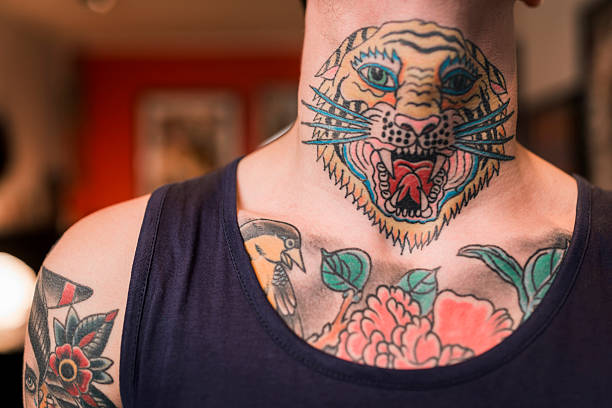Contents
1. Neck tattoos and workplace standards

Picture this: You walk into a bustling office, your sleeves rolled up, ready to tackle the day. But as you catch a glimpse of your coworker, you notice something striking – a vibrant tattoo peeking out from beneath their collar, winding its way up their neck like a colorful serpent.
Neck tattoos are like bold statements etched onto the canvas of our skin. They can be intricate, meaningful, or simply stunning pieces of art. But when it comes to the workplace, the rules aren’t always as flexible as we’d like them to be.
Traditionally, workplaces have had strict standards when it comes to visible tattoos. The neck, being front and center, often falls under this scrutiny. Some companies prefer a clean-cut appearance, believing tattoos might distract or deter clients or customers. Others fear they may not align with the company’s image or values.
But hey, times are changing! With the rise of creative industries and a shift towards embracing individuality, some workplaces are loosening up their collar, so to speak. Start-ups, tech companies, and creative agencies often welcome tattoos with open arms, seeing them as an expression of personality and creativity.
However, even in these more liberal environments, there can still be limits. A tiny hummingbird tattoo might be seen as charming, but a sprawling dragon might raise a few eyebrows. It’s all about finding that balance between self-expression and professionalism.
Ultimately, whether you’re rocking a neck tattoo or not, it’s about respect – respect for yourself, your colleagues, and the company you represent. So, before you go under the needle, it might be worth considering how your ink could impact your career path.
In the end, whether you’re a rebel with inked sleeves or a clean-cut professional, what matters most is your talent, dedication, and the value you bring to the table. So, wear your tattoos proudly, but remember, it’s not just about what’s on your skin, but what you bring to the job every day.
2. Company policies regarding neck tattoos in the workplace

Company policies regarding neck tattoos in the workplace can vary widely depending on the industry, company culture, and regional norms. Here’s an overview of some typical methods:
1. Strict Policies: In traditional or conservative industries like finance, law, or corporate environments, you’re more likely to encounter strict policies against visible tattoos, including those on the neck. These companies often prioritize a polished and professional appearance to maintain their image and reputation.
2. Cover-Up Requirements: Some companies may allow tattoos but require employees to cover them while at work, especially if they’re on areas like the neck, face, or hands. This could involve wearing clothing with high collars or using makeup or specialized tattoo cover-up products.
3. Case-By-Case Basis: In more progressive or creative industries, company policies regarding tattoos might be more flexible. Determining whether visible tattoos, like those on the neck, are acceptable may depend on various factors such as the tattoo’s size, content, and location, with decisions made on a case-by-case basis. as well as its potential impact on client interactions.
4. Explicit Permission: Certain companies may have specific policies where employees must seek explicit permission from management or HR before getting tattoos in visible areas like the neck. This allows the company to evaluate each situation individually and ensure that the tattoo aligns with the company’s values and standards.
5 No Policies: In some workplaces, especially smaller businesses or startups with a relaxed culture, there might be no explicit policies regarding tattoos at all. In these cases, it’s often up to individual managers or teams to decide what is acceptable within their respective departments.
Employees need to familiarize themselves with their company’s dress code and tattoo policies, as violating these policies could have consequences ranging from a simple request to cover up to more serious disciplinary action. Additionally, as attitudes towards tattoos continue to evolve, companies may adapt their policies accordingly, so it’s always a good idea to stay informed and communicate with HR or management if you have any questions or concerns.
3. Cultural perspectives on neck tattoos in the workplace

1.Western Cultural Perspective
In many Western cultures, including the United States and much of Europe, tattoos have historically been associated with counterculture, rebellion, and individuality. However, as tattoos have become more mainstream, attitudes towards them in the workplace have shifted. While there are still industries and companies with conservative dress codes that may frown upon visible tattoos, especially those on the neck, there’s also a growing acceptance of tattoos as a form of self-expression. In some creative fields, like design or advertising, neck tattoos may even be seen as a symbol of creativity and authenticity. Overall, Western cultural perspectives on neck tattoos in the workplace are diverse, ranging from strict policies against visible tattoos to more lenient attitudes that embrace individuality.
2.Japanese Cultural Perspective
In Japan, tattoos have a complex cultural significance deeply rooted in tradition, symbolism, and social stigma. Historically associated with criminality and the yakuza (Japanese organized crime syndicates), tattoos have long been taboo in mainstream Japanese society. While attitudes towards tattoos are gradually changing, particularly among younger generations, visible tattoos, including those on the neck, are still often viewed negatively in professional settings.
Many Japanese companies have strict dress codes that require employees to cover tattoos while at work, as tattoos are still commonly associated with delinquency and may be perceived as unprofessional. Despite the growing popularity of tattoos as a form of personal expression, especially among young people, the stigma surrounding visible tattoos in the workplace remains prevalent in Japanese culture.
3.Pacific Island Cultural Perspective
In numerous Pacific Island cultures, tattoos carry profound cultural and spiritual meanings, representing aspects of identity, heritage, and social standing. Traditional tattooing practices, such as the intricate designs of Polynesian tatau or the hand-tapped motifs of Melanesian and Micronesian cultures, have been passed down through generations as rites of passage and markers of belonging. In these cultures, tattoos are celebrated as expressions of cultural pride and connection to one’s ancestors.
However, attitudes towards tattoos in the workplace can vary depending on the specific cultural context and individual company policies. While some Pacific Island companies may embrace tattoos as a reflection of cultural heritage and identity, others may still adhere to more conservative dress codes that require employees to cover tattoos, including those on the neck, while on duty. Overall, Pacific Island cultural perspectives on neck tattoos in the workplace reflect a balance between honoring traditional tattooing practices and navigating modern professional expectations.
4. Impact on Career Advancement

The impact of neck tattoos on career advancement can vary significantly depending on the industry, company culture, and individual perceptions. Here are four key considerations:
1. Industry Norms: Certain industries, such as finance, law, and corporate environments, often uphold conservative standards for professional appearance. In these fields, visible tattoos, especially those on the neck, might be viewed as unprofessional or distracting, potentially hindering career advancement. Employees in these industries may face challenges in advancing to higher positions if their tattoos conflict with company expectations.
2. Company Culture: Company culture plays a significant role in determining how neck tattoos are perceived and their impact on career advancement. In companies with progressive or creative cultures, tattoos may be more accepted and even celebrated as expressions of individuality. In such environments, employees with neck tattoos may not face significant barriers to career advancement, as long as their work performance meets or exceeds expectations and their tattoos align with the company’s values.
3. Client-Facing Roles: For employees in client-facing roles, the impact of neck tattoos on career advancement may be more pronounced. Some clients or customers, particularly those in conservative industries or older demographics, may have negative perceptions of visible tattoos. In these cases, employees with neck tattoos might encounter challenges in building rapport, gaining trust, or securing new business opportunities, potentially limiting their career advancement prospects within the company.
4.Leadership and Management Roles: The perception of neck tattoos in leadership and management roles can vary depending on the organization’s leadership style and the industry’s norms. While some companies prioritize traditional professionalism and may prefer leaders with a conventional appearance, others value authenticity and diversity of experience. Employees with neck tattoos seeking advancement into leadership positions may need to demonstrate exceptional skills, leadership qualities, and a track record of success to overcome any biases or stereotypes associated with their tattoos.
Overall, the impact of neck tattoos on career advancement is multifaceted and influenced by various factors, including industry norms, company culture, client interactions, and leadership perceptions. While tattoos are becoming more accepted in many workplaces, individuals with neck tattoos may still face challenges in certain industries or roles and may need to navigate these challenges strategically to advance in their careers.
5. Individual Expression vs. Professional Image with neck tattoos

The clash between individual expression and maintaining a professional image is at the heart of the debate surrounding neck tattoos in the workplace. Here’s a closer look at this dynamic:
Individual Expression
Neck tattoos, like all tattoos, are often deeply personal expressions of identity, beliefs, and experiences. They can be symbolic, cultural, or simply a form of artistic self-expression. For many people, getting a tattoo, especially one on a visible area like the neck, is a deliberate choice to showcase a part of who they are to the world. Tattoos can serve as reminders of significant moments in life, representations of cultural heritage, or statements of individuality. For individuals with neck tattoos, the decision to ink their necks may be a bold assertion of their right to express themselves authentically and unapologetically.
Professional Image
In contrast, maintaining a professional image in the workplace often involves adhering to certain standards of appearance and behavior. In many industries, a polished and professional appearance is considered essential for building trust with clients, colleagues, and superiors. Visible tattoos, particularly those on the neck, can sometimes be perceived as unprofessional or even intimidating by traditional standards. Employers may worry that visible tattoos could distract from the company’s brand, create discomfort among clients or customers, or convey an image that doesn’t align with the organization’s values or industry norms.
Finding Balance
Navigating the tension between individual expression and professional image is a delicate balancing act for employees with neck tattoos. While they have the right to express themselves freely, they also must consider the potential impact of their tattoos on their career prospects and workplace relationships. This might involve making strategic decisions about the content, placement, and visibility of their tattoos, as well as respecting company policies and industry expectations. Some individuals may choose to cover their neck tattoos while at work to maintain a professional appearance, while others may seek out workplaces that embrace diversity and allow for greater self-expression.
Ultimately, the question of individual expression versus professional image with neck tattoos underscores broader conversations about diversity, inclusion, and acceptance in the workplace. As societal attitudes towards tattoos continue to evolve, workplaces are increasingly recognizing the value of embracing employees’ diverse backgrounds, experiences, and forms of self-expression, including tattoos. However, finding a balance between individuality and professionalism remains an ongoing challenge for both employees and employers.
6. Customer Perception of neck tattoos in the workplace

In the realm of customer perception in the workplace, the presence of neck tattoos on employees can significantly influence how clients view a business. Imagine a scenario where a customer walks into an establishment and notices an employee with a striking neck tattoo. The visibility of such tattoos often captures immediate attention, prompting various reactions from customers.
For some customers, encountering an employee with a neck tattoo may evoke a sense of intrigue or fascination. It’s akin to stumbling upon a unique piece of artwork adorning the neck, which stands out prominently and leaves a lasting impression. In industries where creativity and individuality are valued, such as the arts, entertainment, or fashion, customers might regard neck tattoos as symbols of self-expression and authenticity, aligning with the company’s cultural ethos.
Conversely, in more conservative sectors like finance, law, or healthcare, the presence of neck tattoos on employees might elicit different reactions from customers. In these settings, where being professional and following traditional rules are important, tattoos that can be seen, especially on the neck, might make people wonder if the person is right for their job. Some customers may perceive neck tattoos as symbols of rebellion or non-conformity, potentially undermining their confidence in the employee’s abilities and professionalism.
Navigating customer perceptions of neck tattoos requires a delicate balance between embracing individuality and meeting customer expectations. While some customers may appreciate the uniqueness and personal expression conveyed by neck tattoos, others may prefer a more conventional appearance from the employees they interact with. Businesses must consider the diverse perspectives of their customer base and ensure that their policies regarding visible tattoos, including those on the neck, strike a harmonious balance between fostering inclusivity and maintaining positive customer relationships.
7. Legal Implications of neck tattoos in the workplace

The legal implications of neck tattoos in the workplace can be multifaceted, touching upon issues of discrimination, workplace safety, and employee rights. Employers must navigate these complexities while upholding the law and fostering a fair and inclusive work environment.
One legal consideration regarding neck tattoos is the potential for discrimination claims. If an employer enforces policies that disproportionately affect employees with neck tattoos, it could be construed as discrimination based on appearance or personal characteristics. This could lead to legal challenges under anti-discrimination laws, particularly if the policies are not justified by legitimate business reasons.
Additionally, workplace safety regulations may come into play when it comes to neck tattoos. For example, in industries where employees are required to wear personal protective equipment (PPE), such as hard hats or respirators, neck tattoos could interfere with the proper fit or function of the equipment. Employers must keep their employees safe by law. This might mean they need rules about tattoos you can see, like ones on the neck, to keep everyone safe.
Furthermore, employees have rights under labor laws that protect their freedom of expression and personal autonomy, including the right to display tattoos, including neck tattoos, as a form of self-expression. Employers must strike a balance between enforcing legitimate workplace policies and respecting employees’ rights to express themselves.
Overall, the legal implications of neck tattoos in the workplace underscore the importance of clear and consistent policies that are applied fairly and without discrimination. Employers should carefully consider the legal landscape and seek legal guidance when implementing policies regarding visible tattoos, including those on the neck, to ensure compliance with relevant laws and regulations while fostering a positive and inclusive work environment.
8. Changing Attitudes towards neck tattoos in the workplace
Changing attitudes towards neck tattoos in the workplace reflects a broader shift in societal perceptions of body art and self-expression. In recent years, more people have been getting neck tattoos, and it’s becoming more accepted to have them even in professional jobs.
Once viewed as taboo or unprofessional, neck tattoos are now increasingly embraced as symbols of individuality and creativity. This shift can be attributed to several factors, including evolving cultural norms, generational changes, and the influence of popular culture.
Younger generations, in particular, are more likely to view neck tattoos as a form of self-expression rather than a mark of rebellion or defiance. As these individuals enter the workforce and assume leadership positions, they bring with them more progressive attitudes toward body art, including tattoos on the neck.
Popular culture, including the rise of tattoo-focused reality shows and the visibility of celebrities with neck tattoos, has also played a role in shaping attitudes towards neck tattoos. As tattoos become more mainstream and celebrities proudly display their ink, the stigma surrounding visible tattoos, including those on the neck, has begun to fade.
Furthermore, companies in creative industries or those with a more relaxed corporate culture are leading the way in embracing neck tattoos in the workplace. These organizations recognize the value of diversity and authenticity and view tattoos as an integral part of their employees’ identities.
As a result of these changing attitudes, many workplaces are revisiting their policies regarding visible tattoos, including those on the neck. Some companies have relaxed their dress code policies to allow employees to display tattoos more freely, while others have implemented guidelines that focus on the content and professionalism of the tattoos rather than their placement.
Overall, the changing attitudes towards neck tattoos in the workplace reflect a broader shift toward greater acceptance of individuality and self-expression. As society changes, more people view neck tattoos as ways to express themselves instead of things that could stop them from doing well in their jobs.
Summary
In recent years, there has been a significant shift in societal attitudes towards neck tattoos in the workplace. Once considered taboo or unprofessional, neck tattoos are now increasingly accepted and even celebrated as symbols of individuality and creativity. This change can be attributed to evolving cultural norms, generational shifts, and the influence of popular culture, including tattoo-focused reality shows and celebrity endorsements.
Younger generations, in particular, view neck tattoos as forms of self-expression rather than rebellion. Creative industries and companies with relaxed corporate cultures are leading the way in embracing neck tattoos, prompting many workplaces to revisit their policies. Overall, the changing attitudes towards neck tattoos reflect a broader acceptance of individuality and self-expression in professional settings.





